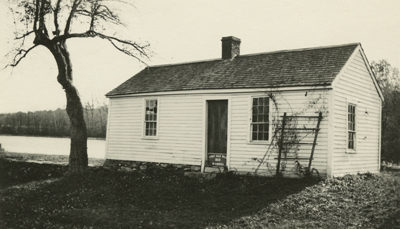| |
From the Old World to the New
Benjamin Hanks, Sr. (1665-1755), the first member of the New England branch of the Hanks family, arrived in Plymouth Colony, Massachusetts, from England in 1699. Two of his descendents, Rodney Hanks and Horace Hanks, built the Hanks Silk Mill in 1810.
As early as 1768, the Hanks family was engaged in raising silkworms and doing a limited amount of home manufacturing. William Hanks (1728-1807), grandson of Benjamin Hanks, Sr., was among the largest silk raisers in the country. Hanks family history maintains that he sent to England for mulberry trees, planted the first of these trees in Connecticut, and made “the first handmade silk in the Colonies, all silk up to that time having been imported.” In 1786, William Hanks joined with others in Windham County similarly engaged, intending ultimately “to bring about a silk manufactory”—a term sometimes used by writers of that day to describe a silk-raising operation with appliances for hand reeling of silk.
A Family of Inventors
The Hanks family seemed to breed innovators and inventors. Uriah Hanks (1736-1809), father of Rodney Hanks, was a “blacksmith, carpenter, gunsmith, clockmaker, nail cutter, wire drawer, a remarkable ingenious man.” During the American Revolution he constructed a wire drawing apparatus, the first such machine in America. Another of Uriah’s sons, Colonel Benjamin Hanks (1755-1824) was a clockmaker and established a foundry. It is believed that he cast the first bells and bronze cannons made in America. Rodney Hanks, the builder of our mill, also was active in other forms of manufacturing, including woolen goods and cannon swabs.
The 1810 Hanks Silk Mill
In the 19th century, silk manufacture became a subject of great interest in the United States. Constant efforts were made, as had been the case with cotton, to construct machinery that would spin silk into thread. Rodney (1782-1846) and his nephew, Horace Hanks (1780-1850), worked on that idea. About 1800, Horace invented the double wheel-head for the purpose of spinning silk.
In 1810, Rodney and Horace Hanks built a 12 ft. by 12 ft. mill building on Hanks Hill in Mansfield. There, using “machinery that their own mechanical ingenuity had devised,” they successfully manufactured sewing silk and twist (a more highly twisted type of silk thread used primarily for sewing buttonholes). This mill has the distinction of being the first powered silk mill in the United States. A stream on the Hanks property was diverted to power the waterwheel that ran the mill’s equipment. Initially the mill used silk from locally grown cocoons, but in later years it was found to be more profitable to use imported Asian cocoons.
The “Thread” Continues
In 1821, Rodney built another sewing silk mill in Mansfield and involved his young son, George Rodney (1808-1889), in the business. This mill appears to have failed about 1828. It was not until 1854 that George Rodney Hanks actively entered the field of silk manufacture. He built a new mill on Hanks Hill in Mansfield, which he personally supervised until 1858, when he turned the establishment over to his two older sons, George Philo (1833-1908) and John Samuel (1834-1894). According to Manufactures of the United States in 1860, Connecticut had 19 establishments for the production of sewing silk and twist—three times more than anywhere else in the United States. These companies produced nearly 146,000 pounds of sewing silk and twist valued at more than one million dollars. The Hanks brothers operated this mill until its destruction by fire in 1882. That same year, with the support of their father, they not only rebuilt the Mansfield mill, but opened another mill at nearby Gurleyville, which operated until 1929.
 |
The Hanks Silk Mill in Mansfield, Connecticut, in 1931. By this time, the 1810 mill building had been moved from its original stream-side site where the family built two subsequent mill buildings. In later years, the 1810 mill building was used for storage by the Hanks family. THF101184 |
The Hanks Silk Mill Comes to Greenfield Village
Many people helped Henry Ford acquire buildings and objects for his new museum and historical village. One of these people was W. W. Taylor, Ford’s New England agent. In the late 1920s, Taylor met Ozro Hanks (1857-1929), George Philo’s son, a man who had spent his life working in the family silk business. Ozro Hanks wanted to donate the 1810 silk mill building to Greenfield Village, but died before he could do so. In 1931, Ozro’s widow, Nettie, made her husband’s wish a reality and the Hanks Silk Mill was moved to Dearborn. It was reassembled in Greenfield Village in 1932.
| |
-- Christine Jeryan, Historical Resources Department
|
Be sure and stop by the Hanks Silk Mill when Greenfield Village
reopens on April 15. |
|
|

